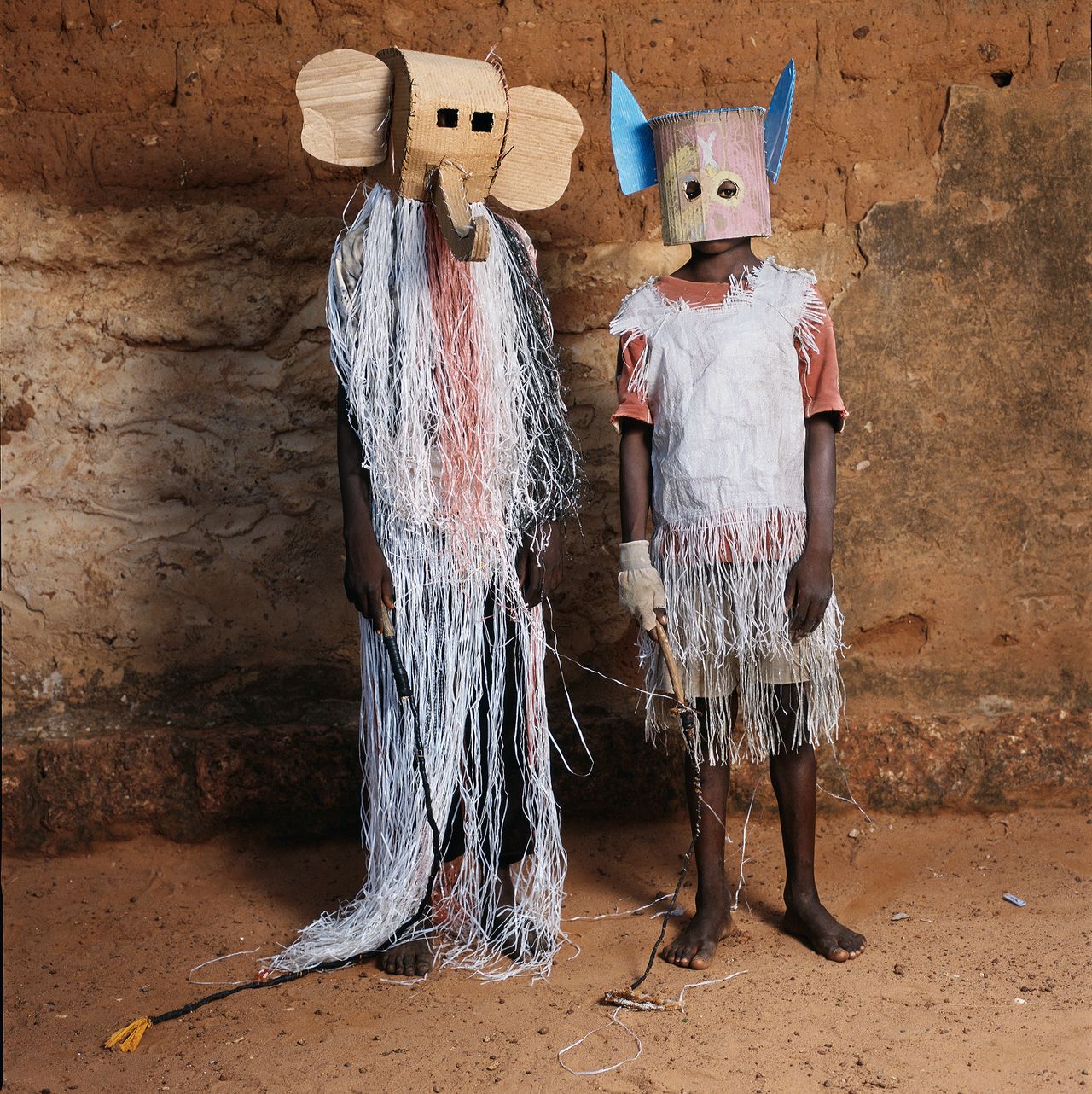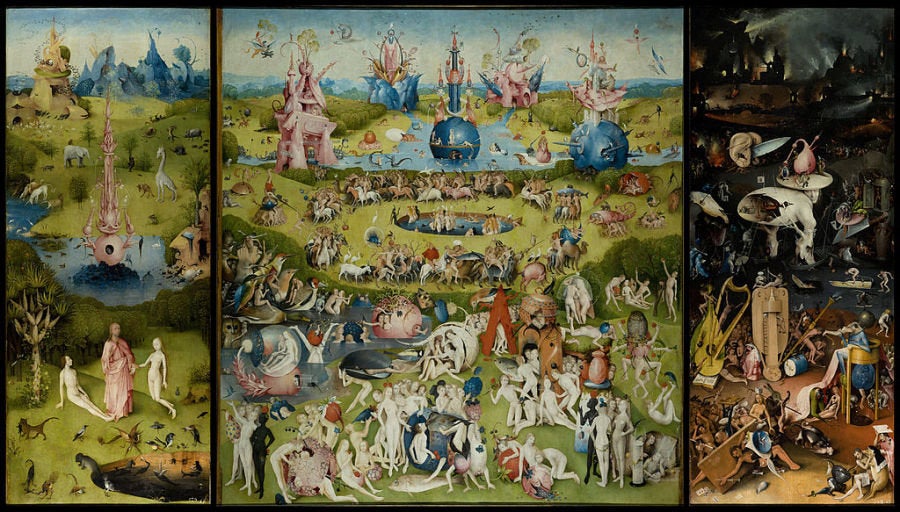Wearing a mask doesn't just conceal the face of the wearers. It transforms their entire beings, ushers them into a liminal realm between the natural and spiritual worlds, where fixed identity is at the mercy of creativity and mythology.
Artists have long been transfixed by the divine powers of disguise, their ability to metamorphose a mood as well as a person, revealing how flimsy both have been all along. In the 1970s, photographer Ralph Eugene Meatyard placed grotesque masks on his children's faces, arranging them to pose for monstrous family portraits. In the late 1990s, Forcefield, a noise rock band and art collective, crafted head-to-toe knit ensembles that turned the musicians into human stuffed animals.
Today, contemporary artist Nick Cave crafts elaborate sound sculptures that swallow human beings whole, turning them into wild, vibrant works of moving artwork. A recent exhibition, dubbed "Disguise," featured artists from the African diaspora, exploring the aesthetics and politics of masks as they relate to hybrid identities.

But of course, outside of the art world, cultures around the world have been transmuting their appearances and transcending themselves for far longer. In Nigeria, priests and priestesses use costumes to assume the posture of mythic characters. In Haiti, voodoo practitioners believe ritual ensembles possess the power to turn wearers into magical beings. In Brazil, the Caribbean, Benin, Ghana, Sierra Leone, and Burkina Faso, among others, masquerade is an integral aspect of spirituality, culture, and the mystical space where they intersect.
Photographer Phyllis Galembo, working at the nexus of art and anthropology, has made documenting such rituals her life's work. Since visiting Nigeria in 1985, Galembo has travelled through Africa and America with her camera in tow, documenting the many elaborate, otherworldly, extraordinary masks and costumes she encountered. "I always had an interest in costume and ritual," Galembo told The Huffington Post. "It was always something that appealed to me."
"I think masquerade is pretty amazing," she continued. "It’s always full of surprises; there's always something new and different to find. Going to a place like Mexico, somewhere you think you know, and you discover something you never thought you would. I appreciate how people do things, how creative people are. I’m not talking about the costumes that come out of a box set here, but the things people make. It's wonderful to watch them put their personal touches on it."
The masquerades Galembo documents each have their origin story. Ghana's tradition got its start when two Ghanaian men in the 1920s, frustrated after being excluded from the social gatherings of Europeans, decided to dance in masks at local bars. They soon turned the practice into a regular gathering of their own, their costumes serving as topsy-turvy simulacrums of religious and political figures.
In Nigeria, the Okpella masquerade celebrates the harvest and funerals, while also paying homage to guardian spirits looking after the village. The festival is based on opposites, with the lead masquerade character playing the wise and beautiful Ancient Mother, contrasted with Idu, an ugly and cruel bush monster.
During Ramadan in Burkina Faso, Muslims participate in the Dodo masquerade. On the night of the full moon, masqueraders sing and dance from house to house, performing in exchange for money, donning elaborate masks and costumes made from dried gourd and horns. The ritual tells the tale of a hunter who breaks a promise and is turned into a monster, banished into the forest as a result.

The masquerades Galembo documents each have their origin story. Ghana’s tradition got its start when two Ghanaian men in the 1920s, frustrated after being excluded from the social gatherings of Europeans, decided to dance in masks at local bars. They soon turned the practice into a regular gathering of their own, their costumes serving as topsy-turvy simulacrums of religious and political figures.
In Nigeria, the Okpella masquerade celebrates the harvest and funerals, while also paying homage to guardian spirits looking after the village. The festival is based on opposites, with the lead masquerade character playing the wise and beautiful Ancient Mother, contrasted with Idu, an ugly and cruel bush monster.
During Ramadan in Burkina Faso, Muslims participate in the Dodo masquerade. On the night of the full moon, masqueraders sing and dance from house to house, performing in exchange for money, donning elaborate masks and costumes made from dried gourd and horns. The ritual tells the tale of a hunter who breaks a promise and is turned into a monster, banished into the forest as a result.
Each masquerade tradition comes with different origins, guidelines and means of expression. Materials incorporated into the lavish costumes range from twigs to cardboard to leaves to body paint to feathers and so much more. The glue that binds them all, of course, is the creative spirit that inspires so many humans, regardless of time and place, to want to build, play and make themselves anew.

Each masquerade tradition comes with different origins, guidelines and means of expression. Materials incorporated into the lavish costumes range from twigs to cardboard to leaves to body paint to feathers and so much more. The glue that binds them all, of course, is the creative spirit that inspires so many humans, regardless of time and place, to want to build, play and make themselves anew.
Galembo archives traditions whose details cannot be described, they must be seen. Encountering her work, one does not just witness the transformation and mysticism taking place. The viewer is folded into the magic of the mask as well. "My work is just an appreciation of other cultures and the creativity of people in general," Galembo said. "With so little they create so much. It’s always amazing. We need a little more of that."
Galembo's photographs have been compiled into a book titled Maske, available from D.A.P.


